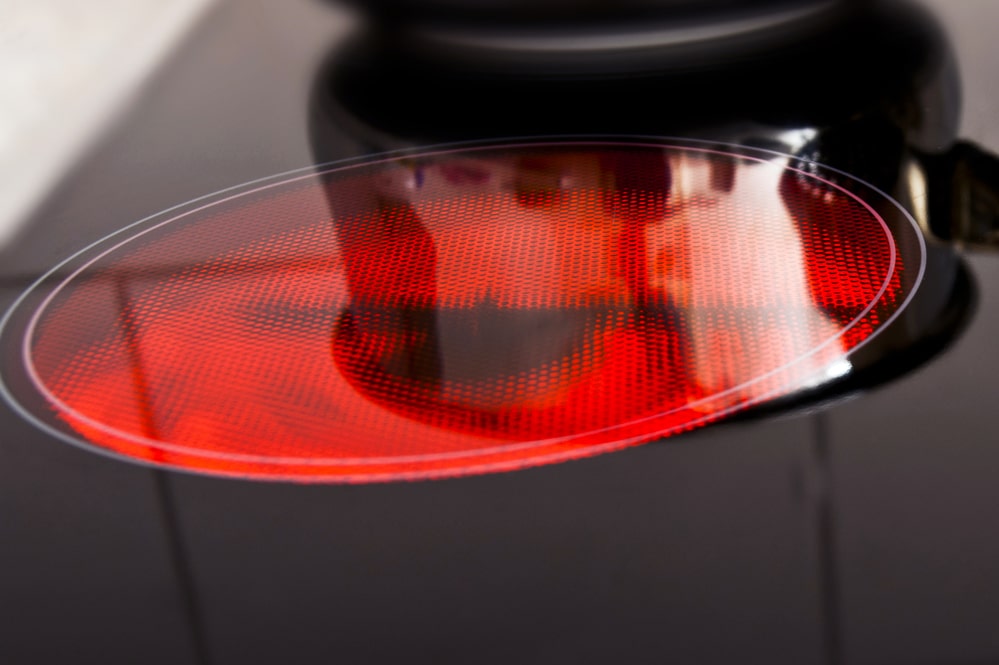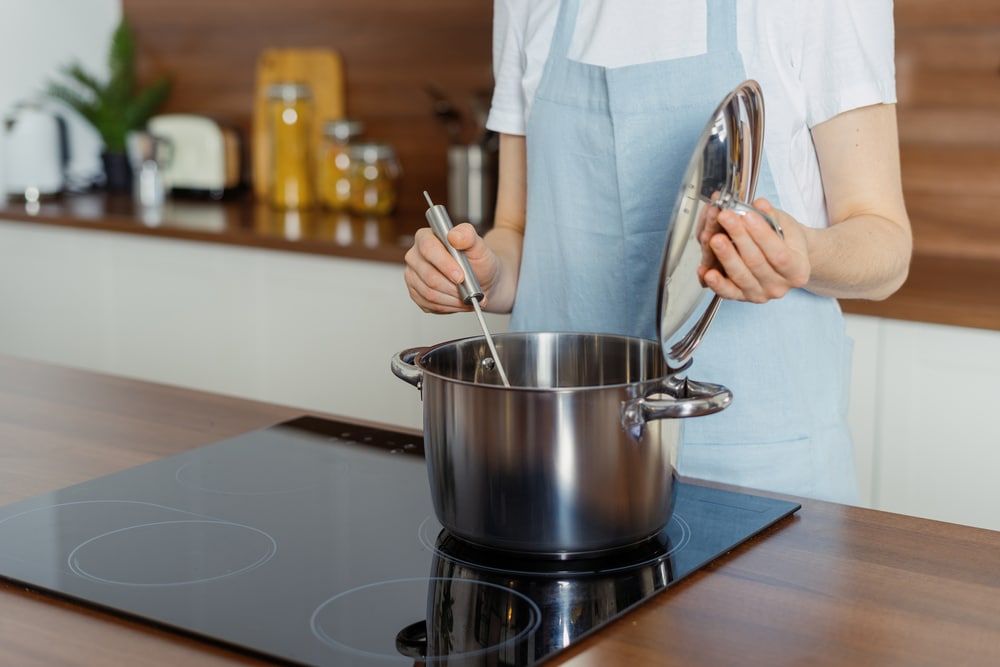Last Updated on February 23, 2023
“What is a ceramic hob?” is a question you might find yourself asking when shopping for new appliances or a new kitchen. When you begin to invest in essential technology for your kitchen, you’ll discover a wide range of electric hobs available for cooking.
Induction hobs, ceramic hobs, and electric hob options all have their pros and cons to consider. The ceramic glass hob is one of the more common ovens for older houses and a popular low-budget solution for people searching for attractive cooking tools. However, many people still don’t know how to tell the difference between halogen and ceramic hobs or solid plate vs ceramic hobs.
Today, we’re going to explore the features of a ceramic hob and discuss which kitchens these cooking solutions may be best suited to.
What Is a Ceramic Hob? The Basics
A ceramic hob is a cooker that uses a glass-topped heating element powered by electricity. The system works by heating through the glass and the pots or pans you’re using.
A number of hob ring heating components are covered by a ceramic glass surface that helps you cook at different temperatures.

A ceramic hob is similar to a standard electric hob. Electric plate hobs rely on electricity to heat a heating element within your cooker, with different heating levels for each cooking zone. Unlike an induction hob, which uses a magnetic field to create heat, ceramic hobs don’t require a special kind of cooking utensil to cook with.
A ceramic hob doesn’t give you the same amount of control you’d get over your heating elements with gas hobs and induction hobs. However, you should still be able to cook easily enough with these devices. Notably, ceramic hobs are frequently lovely due to their well-designed cooking area and reasonably priced for all types of homes.
Ceramic Hob vs Induction Hob: Which Is Better?
The question of ceramic hob vs induction hob is a common one for a lot of homeowners. As hob types go, the ceramic hob is quickly being replaced by the induction hob in many homes because it’s widely considered to be more old-fashioned.
While induction and ceramic hobs might look the same on the surface – with a solid plate for cooking on the top – these hobs work very differently. Both allow you to achieve the streamlined glass look in your kitchen with an easy-to-clean surface.
Induction Hobs
However, an induction hob will only start the cooking process when the copper coils underneath the glass surface form a magnetic field with the right special pans for an induction cooker. Induction hobs are generally more cost-effective when saving energy in your kitchen because you’re not wasting gas and electricity when not heating your pots.
Induction ovens also give you more temperature control options, a wider range of capabilities, and safety features. For instance, one of the most significant safety features of an induction hob is that it will only heat up when you’re using suitable pots and pans on the surface. The magnetic field breaks when you remove the pots and pans, and the heat stops.
Ceramic Hobs
Ceramic hobs don’t require any special pans, which means you can enjoy cooking with your current cookware without needing any replacements. Ceramic hobs are great for people with a limited budget because they can be much cheaper than alternative induction hobs. These products also come in a variety of styles and sizes.
Most models of ceramic hobs are relatively easy to use, and you can usually find replacements if you have any issues with the components, like the glass tops. However, you won’t have the same control or energy efficiency you’d get with an induction hob.
How Does a Ceramic Hob Work?
A ceramic hob will look virtually identical to an induction hob on the surface.
However, while both have the same glass surface, ceramic hobs have heating elements beneath the surface of each of the cooking zones, which are activated by an electrical current.

A ceramic hob will look virtually identical to an induction hob on the surface. However, while both have the same glass surface, ceramic hobs have heating elements beneath the surface of each of the cooking zones, which are activated by an electrical current.
You’ll see the hobs gradually turn red as the heat increases as you turn your cooking device on. This will show you when you’re ready to use your hob. There are no special requirements for installing a ceramic hob (you need an electrical source).
Ceramic hobs do not use the magnetic field: you don’t have to check to see if a magnet sticks to a pan before using it, and you don’t need the same special pans you need for induction hobs. However, if you want to cook quickly, you might find these devices’ heat and cooking times are a little slow.
Your ceramic hobs’ exact features and functionality will depend on the models you get. Many products now come with touch controls to help you control your heat or start cooking at a specific time. There’s even access to features like automatic fans to blow away smoke and steam when cooking in a busy kitchen.
What Are the Advantages of a Ceramic Hob?
Ceramic hobs are considered a little outdated compared to new induction hobs, though the glass top often makes the two devices look the same. If you’re choosing between a ceramic hob vs induction hob, you may find a ceramic hob is better for you if you’re running low on budget.
Like an induction hob, you can still get an attractive look with your ceramic hobs, including a glass surface you can simply wipe clean after each cooking session. The ceramic hob is affordable and easy to use, with a red light to show you when the heat source is on.
Compared to other hob types, ceramic hobs don’t require special pans or complex installation. Ceramic hobs can accomplish most of the same things as your standard induction hob, whether you want to boil water or roast vegetables.
Pros of this hob type include:
- No special pans or pots are required
- Easy to clean hob surface, which heats evenly.
- Excellent range of design options to choose from
- Potential to use a cast-iron frying pan and similar tools. You don’t need a special pan.
- Red light for heat indicator and to show residual heat
- Timers to start and stop cooking
Most ceramic hobs now also come with intuitive touch-screen displays, so they’re convenient.
What Are the Disadvantages of Ceramic Hobs?
While both ceramic and induction hobs look great, ceramic hobs can’t consistently achieve as much as their more expensive counterparts. With a ceramic hob, you don’t get the speed or temperature control you’d get with gas hobs or a zoneless induction hob.
You’ll also find your ceramic hob isn’t as energy efficient as some of the other hobs on the market. Both ceramic and gas hob options often have issues with energy efficiency. Alternatively, induction hobs are designed to preserve energy as much as possible.
Some of the disadvantages of most ceramic hobs include:
- They’re not energy efficient: Unlike induction hobs that focus on heating the food within your pan, ceramic hobs also heat the air around the pan and the glass surface. The residual heat spreads throughout the hob surface when you’re cooking.
- Minimal control: If you want a lot of control over the heat and residual heat in your oven, a ceramic hob is not for you. Although these devices can come with a heat indicator to help you track the temperature of the hob surface, you won’t have much control.
- Speed: Gas and ceramic hobs waste energy compared to induction hobs, which directly heat the food in your pans. This means you might find your ceramic hobs take longer than induction hobs to cook your food or boil water.
Although an excellent glass surface is one of the leading ceramic hobs’ advantages, it’s also a cause of concern for many people. Moving a pot or plan along the hot glass surface can lead to cracks and scratches. Hot objects can easily damage both ceramic and induction hobs.
Is a Ceramic Hob a Good Investment?
There are plenty of different energy-efficient cooking options for today’s kitchen owners. You can choose from a gas hob to modern electric hobs or ceramic and induction hobs with heat indicators. The right choice for you will depend on your specific preferences. For instance, if you’re choosing between ceramic and induction hobs, induction hobs tend to appeal to people looking for more control.
Induction heats the pan and food rather than the surrounding air and ferrous metals in your oven. Although not every pan supports cooking with induction hobs, you can save a lot of money on energy.
Of course, an induction hob is not the hob for you in all cases. When choosing between gas or ceramic vs induction hobs, you’ll also need to think about what kind of temperature management you want. Gas allows for cooking in two zones or different zones on your cooker to decide how hot you want each pan to be.
A ceramic hob might be an excellent alternative to gas and induction if you want a budget-friendly and easy-to-clean product in your kitchen.
Rebekah is a writer who loves to explore new products and find hacks that make life easier. She has a knack for all things home improvement, health and fitness. So you’ll often find her on Pinterest or browsing Houzz for ideas.
She’s always looking for the next thing to fix up around the house or what gadget might be just right for her lifestyle. Rebekah enjoys exploring new recipes, taking care of her family, and making sure she stays healthy with regular workouts at the gym.

